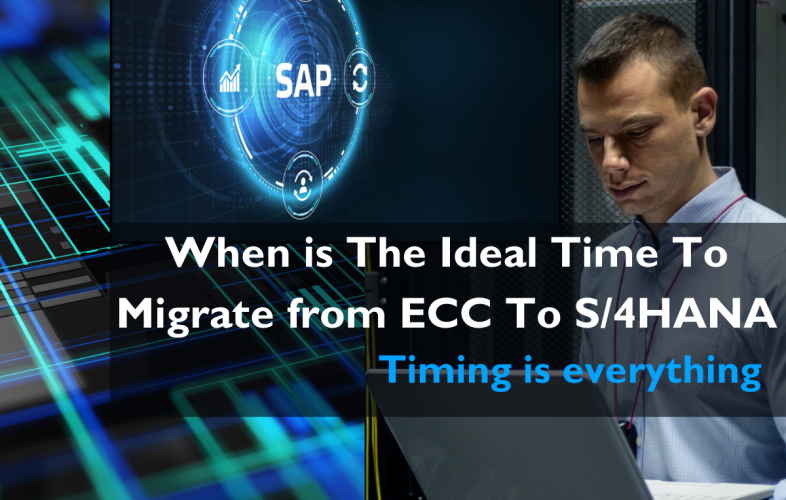Timing is Everything - When is the Ideal Time To Migrate from ECC To S/4HANA
Guest Writer
09 October 2024

SAP ECC has served many organizations well—however, the future beckons with SAP S/4 HANA. SAP S/4 HANA is the next-generation business suite from SAP. But what does this transition entail? And when is the right time to make the move?
This article aims to answer these questions. We’ll explore the benefits of moving from SAP ECC to SAP S/4 HANA and the ideal time to migrate from SAP ECC to S/4HANA. The goal is to provide a comprehensive understanding to help you make an informed decision. Whether you’re a C-level executive, an IT manager, or an ERP specialist, this guide is for you.
Understanding SAP ECC and SAP S/4 HANA
SAP ECC (ERP Central Component) is the older version of SAP S/4HANA. It is a system with a traditional database and user interface. Many businesses have relied on SAP ECC for their core operations. On the other hand, SAP S/4 HANA is built on a more advanced platform called HANA, allowing faster data processing and real-time analytics.
The Difference Between SAP S/4HANA and SAP ECC
The difference between SAP S/4HANA and SAP ECC lies in their architecture, capabilities, and potential for innovation. SAP ECC uses a traditional database, while SAP S/4 HANA leverages the power of in-memory computing.
SAP S/4 HANA also offers an enhanced user experience with SAP Fiori, providing a modern, intuitive interface. In contrast, SAP ECC has a more traditional user interface. Moreover, SAP S/4 HANA supports IoT, machine learning, and AI. This enables businesses to innovate and automate processes. SAP ECC, while robust, lacks these advanced capabilities. This makes SAP S/4 HANA a more future-proof choice for businesses.
Determining The Ideal Time to Migrate from SAP ECC to S/4HANA
Several factors influence the ideal time to move to SAP S/4 HANA. These include the end of mainstream maintenance for SAP ECC, business growth, and digital transformation needs. It’s crucial to align the migration with the company’s strategic goals and digital roadmap.
Assessing Your Business's Readiness
Before deciding to migrate, businesses must look at their preparedness. It involves assessing the IT infrastructure, business processes, and data quality. The migration presents a chance to refine existing data and processes, resulting in more streamlined operations. Additionally, it’s crucial to consider the organization’s ability to adapt to change. This includes the availability of resources for training and change management, which are critical for a successful transition.
Aligning Migration with Business Cycles
The migration should be timed to align with the business cycles, ideally minimizing disruption to the business. This often means scheduling it during slower operational periods or off-peak seasons. It’s also important to consider the budget cycle, as the migration is an investment in the future and requires adequate budget allocation for a smooth transition.
Assessing Your Business's Readiness
Before deciding to migrate, businesses must look at their preparedness. It involves assessing the IT infrastructure, business processes, and data quality. The migration presents a chance to refine existing data and processes, resulting in more streamlined operations. Additionally, it’s crucial to consider the organization’s ability to adapt to change. This includes the availability of resources for training and change management, which are critical for a successful transition.
The Role of SAP ECC's End of Mainstream Maintenance
As SAP ECC moves towards the end of its lifecycle, businesses are encouraged to transition to SAP S/4 HANA. The end of maintenance implies reduced support and updates for SAP ECC. This can pose risks and limitations for businesses, making migrating to SAP S/4 HANA a strategic move to future-proof the organization.
Conclusion
In conclusion, migrating from SAP ECC to SAP S/4 HANA is a strategic move offering numerous benefits. It’s a technical upgrade and a business transformation that can lead to competitive advantage.
The migration timing should be carefully planned, considering business readiness, cycles, and the end of SAP ECC’s mainstream maintenance. This guarantees a seamless transition while optimizing the advantages of the relocation.
